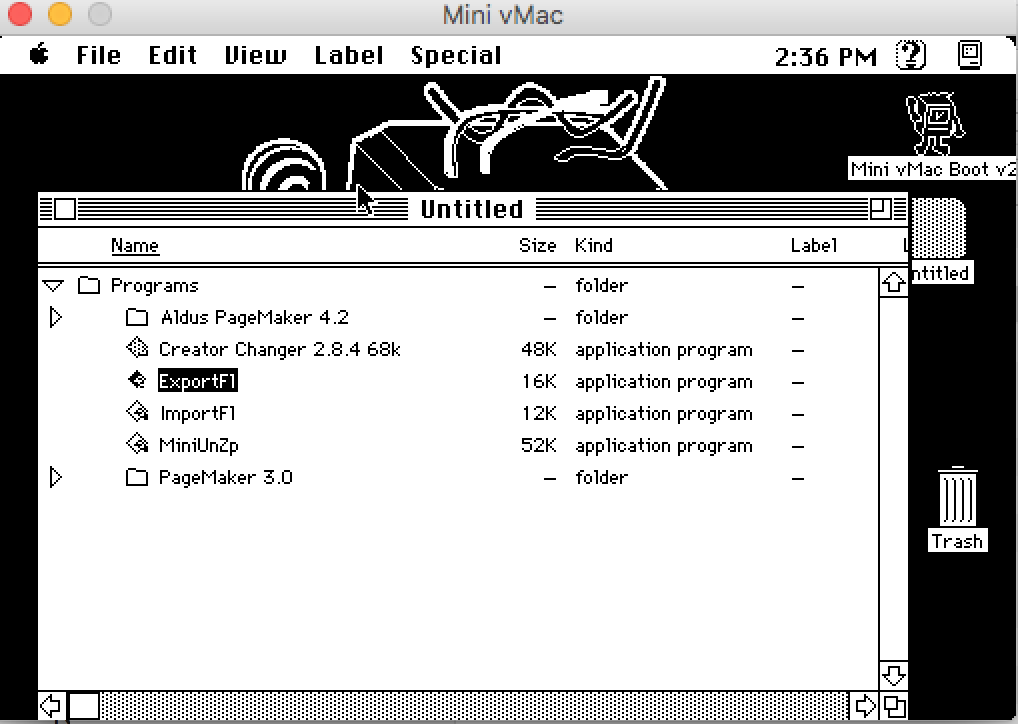
- #Mini vmac transfer files mac os x#
- #Mini vmac transfer files software#
- #Mini vmac transfer files Pc#
As a result, Apple stripped the OS down to a mere 216 KB package, including a 42 KB Finder. That means that System 1.0 needed to work well under lean conditions and fit on a single 400 KB floppy disk. The original Macintosh shipped with only 128 kilobytes of RAM and a single-sided, double-density 3.5″ floppy drive.

RELATED: What Are Teletypes, and Why Were They Used with Computers? The 200 KB Mac Operating System This was a huge contrast to other computer systems that required people to memorize special commands and syntax typed into a command prompt to use their machines. Double-clicking a document or application icon opened it-just point and click. This resembled placing pieces of paper inside a folder on a real desk surface. It included a virtual “desktop” surface as the farthest background layer behind application windows.Īs with the Mac today, System 1.0 displayed files and applications as graphical icons that could be placed spatially on a two-dimensional plane on the desktop or within folders. Macintosh System 1.0 utilized the desktop metaphor pioneered at Xerox PARC (and used earlier on the Apple Lisa) as the conceptual model for working with files and applications.
#Mini vmac transfer files mac os x#
RELATED: 20 Years Later: How the Mac OS X Public Beta Saved the Mac The Desktop Metaphor With the release of 10.12 (Sierra) in 2016, Apple changed the OS name to “macOS,” which is how it continues to be referenced today. A variation of that spanned Mac OS X 10.0 to Mac OS X 10.11. With System 5 in 1987, Apple began calling the OS “Macintosh System Software.” Apple changed the name again to “Mac OS” with the release of Mac OS 7.6 in 1997, and that continued until Mac OS 9. So technically, there isn’t a “Mac OS 1.0,” only System 1.0.

#Mini vmac transfer files software#
Originally, Apple didn’t publicize the version numbers of the system software and referred to it as just “System 1.0” or “System 2.0” internally. Over time, Apple has referred to its Macintosh operating system by different names. RELATED: 35 Years of Microsoft Windows: Remembering Windows 1.0 What’s in a Mac OS Name? Despite that, what set the Mac apart most was its innovative operating system, which went on to inspire how Windows works as well.
#Mini vmac transfer files Pc#
It also pushed the state-of-the-art forward in user interfaces with a completely bitmapped display and support for proportional fonts.Īt the time of its launch, the IBM PC had not yet turned three years old, but Apple found itself on the defensive, running to catch up in market share, as IBM’s PC had already been hailed as the new industry standard for business-class PCs. It brought the graphical user interface (GUI) concept to the masses for the first time and promised a very user-friendly experience compared to most computers on the market. Released in 1984, the Apple Macintosh radically altered the course of personal computer history.


 0 kommentar(er)
0 kommentar(er)
